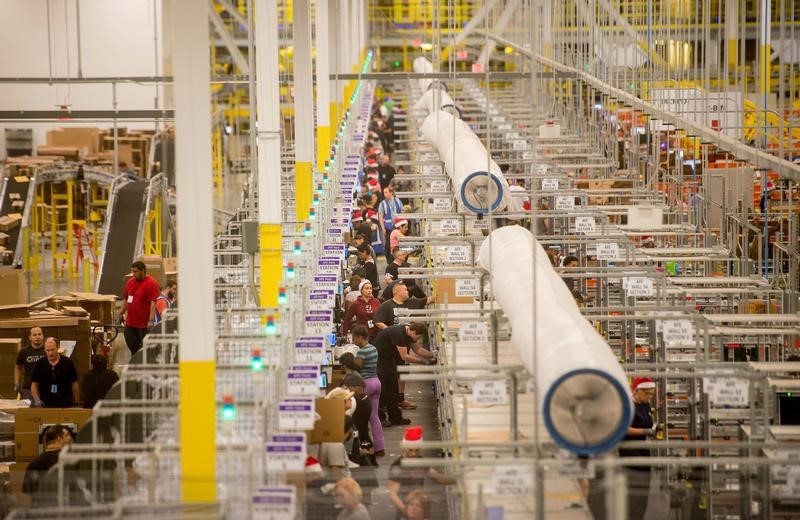By Lucia Mutikani
WASHINGTON (Reuters) - U.S. private employers in April hired the fewest number of workers in more than a year, further diminishing hopes of a strong rebound in economic growth after the first-quarter slump.
The tepid private job gains combined with other data on Wednesday showing a second straight quarterly decline in productivity make it less likely the U.S. Federal Reserve will raise interest rates in June as had been expected at the start of the year.
"The data pile onto recent evidence suggesting increased odds that, by the time the June policy meeting rolls around, the hope of a great spring rebound in real growth will have faded," said Steve Blitz, chief economist at ITG Investment Research in New York.
Private payrolls increased 169,000 last month, the smallest gain since January 2014, the ADP National Employment Report showed. That was well below economists' expectations for an increase of 200,000 jobs.
Hiring slowed almost across the board, with manufacturing losing 10,000 jobs after eliminating 3,000 positions in March, likely reflecting the impact of a strong dollar. Private sector job growth has slowed since November.
March private payrolls were revised down to show 14,000 fewer jobs created than previously reported. The report jointly developed with Moody's Analytics was released ahead of the government's more comprehensive employment report on Friday.
The ADP has a poor track record of predicting nonfarm payrolls, and most economists are maintaining their forecasts for a bounce back in job growth after March's sharp slowdown, which was blamed on bad weather.
They, however, acknowledged there was a slight downside risk. According to a Reuters survey of economists, nonfarm payrolls likely increased 224,000 in April after rising by 126,000 in March.
"ADP typically doesn't do a good job of picking up short-term swings from weather and other temporary factors," said Ted Wieseman, an economist at Morgan Stanley (NYSE:MS) in New York.
"After over-predicting the nonfarm payrolls number in March, ADP will probably undershoot in April as weather swings in the positive direction."
Payrolls will be scrutinized closely for clues on the economy's strength after a mix of cold weather, the buoyant dollar, port disruptions and deep spending cuts by energy firms held first-quarter growth to an anemic 0.2 percent annual pace.
But Tuesday's weak March trade data suggests the economy actually contracted in the first three months of the year after expanding at a 2.2 percent pace in the fourth quarter.
The dollar hit a 10-week low against the euro on the data and a spike in European bond yields, which buoyed demand for the single currency. U.S. Treasury debt prices fell on the European bond sell-off and Apple Inc's (O:AAPL) announcement of a new seven-part bond to help fund dividends and share buybacks.
Stocks on Wall Street were trading lower after Fed Chair Janet Yellen warned that equity market valuations at "this point generally are quite high."
PRODUCTIVITY WEAK
Despite its spotty record, the ADP report joined data on automobile sales and manufacturing in suggesting moderate momentum in the economy at the start of the second quarter.
In a separate report, the Labor Department said nonfarm productivity declined at a 1.9 percent annual rate in the first quarter after dropping at a 2.1 percent pace in the fourth quarter. That was the first back-to-back fall in productivity since 2006.
Productivity rose 0.6 percent from a year ago. Unit labor costs, the price of labor per single unit of output, increased at a 5.0 percent rate in the first quarter. That was the fastest pace since the first quarter of 2014, and followed a 4.2 percent rate of increase in the fourth quarter.
The steadily rising labor costs against the backdrop of weak productivity could further squeeze corporate profits, which already are being pressured by the dollar.
"The weakness of productivity is another reason to believe that the Fed will begin to raise interest rates in the second half of this year," said Paul Ashworth, chief U.S. economist at Capital Economics in Toronto.
Unit labor costs rose only 1.1 percent compared to the first quarter of 2014, a sign that wage inflation remains benign.
But there are signs wage growth is firming. Compensation per hour increased at a 3.1 percent rate in the first quarter, the quickest pace in a year. That came on the heels of data last week showing a solid rise in labor costs in the first quarter.
